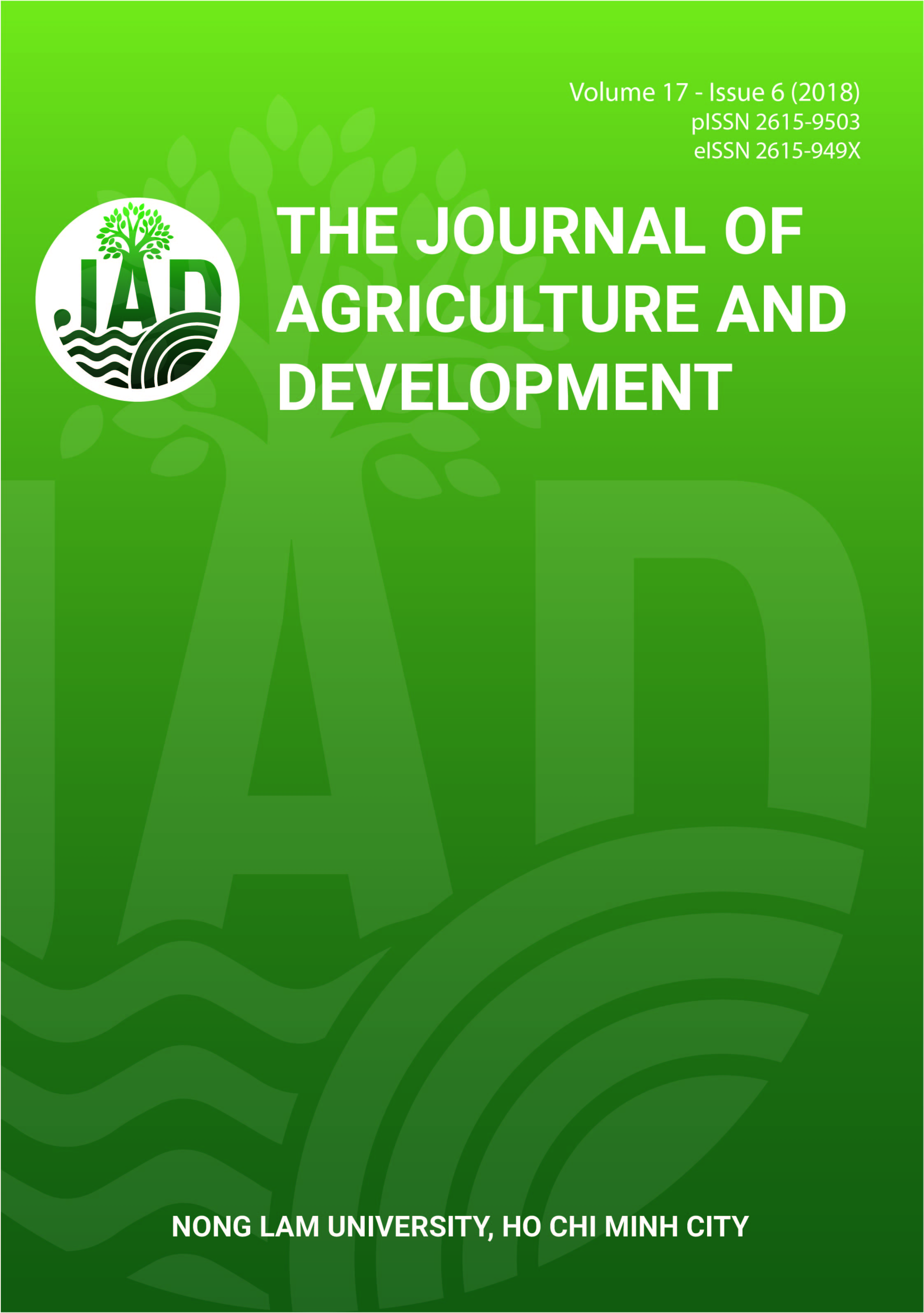Effects of film coating materials on the quality of postharvest ‘Sanh’ orange fruits (Citrus nobilis var. Typica) during storage
Main Article Content
Abstract
Postharvest orange fruit coating is an effective method to replace natural waxes which lost during washing and handling.
The coatings can reduce water loss and impart gloss to the fruit. In this study, the oranges were stored at room temperature (30 ± 2oC) with five coating materials: polyethylene (PE), and polypropylene (PP) bags, polyvinyl chloride (PVC) film, Citra Shine preservatives and 1% chitosan and the control were used. Some typical nutritional values and weight loss were determined during storage time. Research results show that PVC coated ‘Sanh’ oranges could be prolonged their shelf life up to 25 days with low damage ratios (7.10%, lower than other bags) which were acceptable in appearance with green peel color. Ascorbic acid content still maintained at a high level (12.32 mg/100 g), and weight loss relatively low (13.91%). Moreover, pH (3.77) and TSS (9.70) values did not significantly change during storage time.
Article Details
References
AOAC (AOAC International). (2004). Official methods of Analysis. The Association of official chemists 18th ed. Arlington, USA.
Baldwin, E. A., Nisperos-Carriedo, M., Shaw, P. E., & Burns, J. K. (1995). Effect of coating and prolonged storage conditions on fresh organe flavor volatiles, degree brix and ascorbic acid levels. Journal of Agricultural and Food Chemistry 43(5), 1321-1331. https://doi.org/10.1021/jf00053a037
Baldwin, E. A., Burns, J. K., Kazokas, W., Brecht, J. K., Hagenmaier, R. D., Bender, R. J., & Pesis, E. (1999). Effect of two edible coatings with different permeability characteristics on mango (Mangifera indica L.) ripening during storage. Postharvest Biology and Technology 17(3), 215-226. https://doi.org/10.1016/S0925-5214(99)00053-8
Bramlage, W. J. (1986). Physiological effects of waxingon apples. Proceedings of the Annual Meeting of Massachusetts Fruit Growers’ Association (111-113). Massachusetts, USA: Massachusetts Fruit Growers’ Association Inc.
Cordenusi, B. R., Genovese, M. I., Do Nascimento, J. R. O., Hassimoto, N. M. A., Dos Santos, R. J., & Lajolo, F. M. (2005). Effects of temperature on the chemical composition and antioxidant activity of three strawberry cultivars. Food Chemistry 91(1), 113-121. https://doi.org/10.1016/j.foodchem.2004.05.054
Dhall, R. (2013). Advances in edible coatings for fresh fruits and vegetables: a review. Critical Reviews in Food Science and Nutrition 53(5), 435-450. https://doi.org/10.1080/10408398.2010.541568
Drake, S. R., & Nelson, J. W. (1990). Storage quality of waxed and non-waxed “Delicious” and “Golden Delicious” apples. Journal of Food Quality 13(5), 331-341. https://doi.org/10.1111/j.1745-4557.1990.tb00029.x
Fereshteh, K., Asghar, R., & Hosseini, S. H. H. (2017). Shellac, gelatin and Persian gum as alternative coating for orange fruit. Scientia Horticulturae 225, 22-28. https://doi.org/10.1016/j.scienta.2017.06.045
Hagenmaier, R. D., & Shaw, P. E. (2002). Changes in volatile components of stored tangerines and other specialty citrus fruits with different coatings. Journal of Food Science 67(5), 1742-1745. https://doi.org/10.1111/j.1365-2621.2002.tb08716.x
Iglesias, I., & Echeverria, G. (2009). Differential effect of cultivar and harvest date on nectarine colour, quality and consumer acceptance. Scientia Horticulturae 120(1), 41–50. https://doi.org/10.1016/j.scienta.2008.09.011
Jitareerat, P., Paumchai, S., & Kanlayanarat, S. (2007). Effect of chitosan on ripening enzymatic activity: and disease development in mango (Mangifera indica L.) fruit. New Zealand Journal of Crop and Horticultural Science 35(2), 211–218. https://doi.org/10.1080/01140670709510187
Khaliq, G., Muda Mohamed, M. T., Mohd Ghazali, H., Ding, P., & Ali, A. (2016). Influence of gum arabic coating enriched with calcium chloride on physiological: biochemical and quality responses of mango (Mangifera indica L.) fruit stored under low temperature stress. Postharvest Biology and Technology 111, 362-369. https://doi.org/10.1016/j.postharvbio.2015.09.029
Navarro-Tarazaga, M. L., & Perez-Gago, M. B. (2006). Effect of edible coatings on quality of mandarins cv. Clemenules. Proceedings of the Florida State Horticultural Society 119, 350–352.
Nguyen, M. V., Chau, A. T. D., Nguyen, P. N. M., Phan, D. T. A., & Lam, H. T. V., (2005). Effects of temperature on storage and quality of ‘Sanh’ orange fruits. National workshop on Citrus, mango and pineapple VLIR-IUC CTU - Scheme R.2-Fruit trees (135-140). Agriculture Publishing House.
Porat, R., Weiss, B., Cohen, L., Daus, A., & Aharoni, N. (2004). Reduction of postharvest rind disorders in citrus fruit by modified atmosphere packaging. Postharvest Biology and Technology 33(1), 35-43. https://doi.org/10.1016/j.postharvbio.2004.01.010
Rapisarda, P., Bellomo, S., Fabroni, S., & Russo, G. (2008). Juice quality of two new mandarin-like hybrids (Citrus clementina Hort. ex Tan x Citrus sinensis L. Osbeck) containing anthocyanins. Journal of Agricultural and Food Chemistry 56(6), 2074-2078. https://doi.org/10.1021/jf072616e








